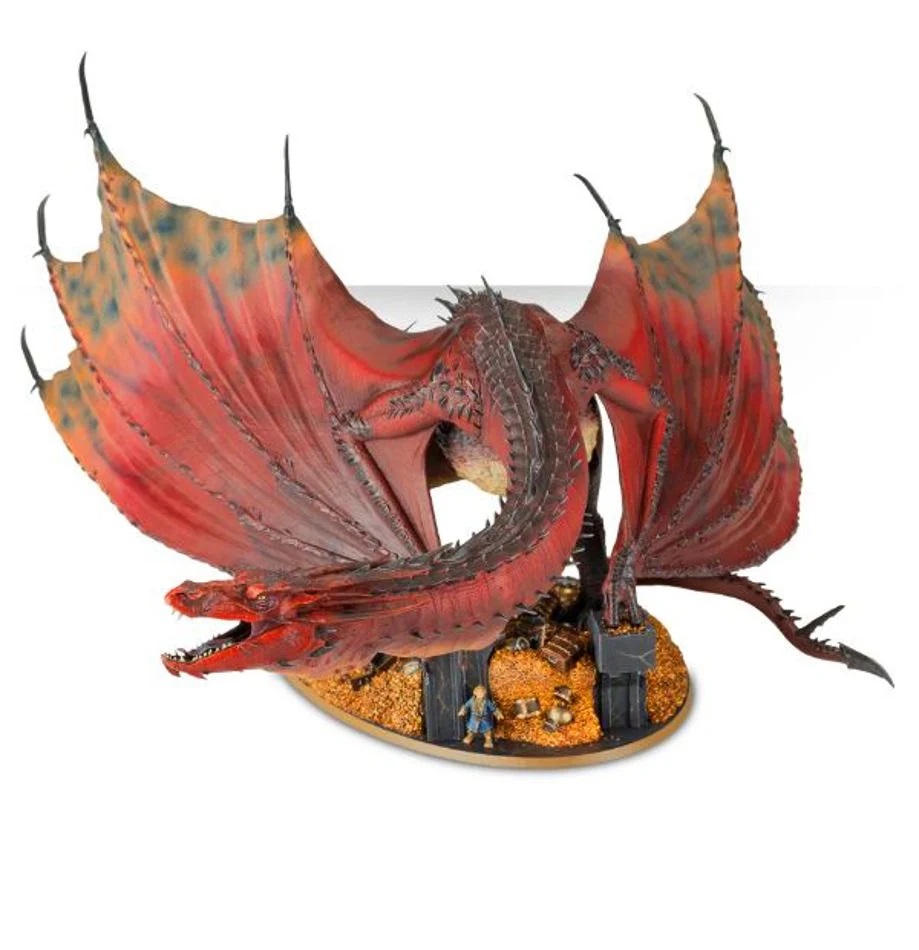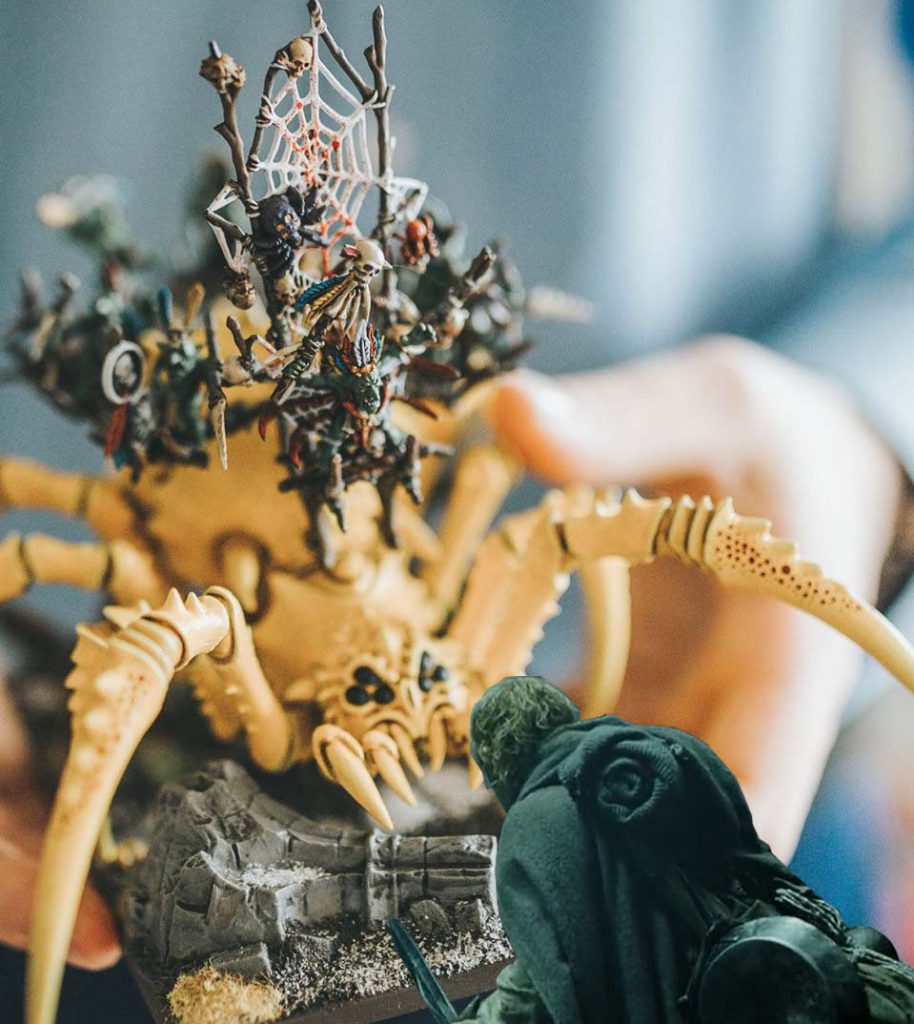G’day Goonhammer readers! If you’re not aware, almost the entire Kings of War community is counting down the days until October 24th and the release of the new Kings of War Gamer’s Compendium. This is going to be a big, red book and it’s going to contain everything needed to play Kings of War and a whole lot more.
We here at Goonhammer were lucky enough to receive a review copy, and this book is packed. Obviously the book contains the Core Rules, but these now incorporate all of the FAQs and erratas published up until this point, and even further expansions on some concepts, notably certain charges. All the army lists (both Core and Uncharted Empires, but not Twilight Kin) are included, and have all the Clash of Kings 2023 changes applied. That’s already a lot, but somehow isn’t the most exciting part.
The Compendium brings three new ways to play Kings of War. Ambush brings in small points games (less than 1000 points), and makes it work with slight modifications to army construction. Siege Rules introduce castles to Kings of War (for the first time since 2nd edition), with a whole host of exciting ways to make epic siege battles between attackers and defenders. The ‘biggest’ game mode to be added is Legendary Games, for battles of 3000 points or more, which possibly contains some of the most exciting content of all the three battle types, and is what we will be covering first.
What are Legendary Games?
The idea of Legendary Games is two-fold:
- to provide a framework within which large games of over 3000 points can be set up.
- to enhance these battles with super-powered magic and units that only such large and crazy games could contain.
The foremost detail is table size. Big armies need space, otherwise it’s just units on train tracks smashing into each other. There aren’t any specific recommendations on what table size suits what points level, but they do provide the sensible alterations to scenarios to match those tables, such as the number of tokens on any given table. They don’t recommend the Dominate scenario, which is sensible given that half the units physically won’t be able to walk that far in six turns.
The next detail is the expansion of Allies to Grand Alliances, which effectively means teaming up with a friend is actively encouraged (or trying to field all of your army collections at once for us more solitary folk). Up to 50% of an army can be spent on Allies in Grand Alliances. In addition, all the standard restrictions of allies such as the taking of unique units, the casting of spells on friendly allies, and even the limitations Inspiring are removed in Grand Alliances.
This means if you want your 4000 point army to be half Orcs and half Goblins, you can finally do it! Of course, you could always do this before in friendly casual games, but having it written in the rulebook is a lot more encouraging.
Magic: The Gathering of Rift-Spells
It is no secret that magic is quite subtle in Kings of War, with no single spell capable of eradicating entire regiments, or making them unkillable. Kings of War magic can certainly alter the course of the game, but requires forethought and planning to get the most out of them. Legendary Games change that entirely.

Subtle is out the window and full-on Michael Bay explosions are in with the new Rift-Spells available in the Channelling Table! There’s simple spells, like Ghost Walk, that give Strider to a unit, which is neat. But then there’s crazy spells, like THE VORTEX, that does D6 Piercing (4) hits to an enemy unit and has a chance to jump to another nearby enemy unit and do it again! Madness!
How could all of this possibly work? Is there even the semblance of balance, we hear you ask? Of course there is. Not only do these spells need to be purchased as part of army composition (The Vortex costs 60 points!), but you are not even guaranteed to cast the spell in any given turn.
Let’s explain.
Rift-Spells are organised into four types according to their effects; Agile, Brawny, Chaotic and Enduring. Each of these has six spells available, numbered 1 to 6 in a table. Players purchase these spells (one of each type), and then at the start of each turn they roll a D6 to see which spell is available for that turn. If the spell that was purchased happens to be the same number as that rolled, that spell can be used in that turn. There’s no rolling to cast, it just happens.
The number of dice rolled to select spells is equal to the sum of Spellcaster tiers in the army. An army full of spellcasters has substantially higher odds of being able to harness the Rift-Spells available to them in these massive battles. Hence to take full advantage of these new spells, a significant investment into magic has to be made with not only the spells themselves, but the spellcasters to get them.
The smart approach when purchasing spells is to select spells of different numbers across the four different types, rather than doubling up on the same number. Purchasing one of each type gives a 66% chance of always having a Rift-Spell available, and that’s before the extra dice from more Spellcaster tiers.
But a section on overpowered magic wouldn’t be complete without a few more examples of these exciting new spells. So here’s four more, one selected from each of the Rift-Spell types:
- Agile: True Shot, ranged attacks from a single friendly unit ignore all modifiers when rolling to hit. Nothing will stop my Flamebearers now!
- Brawny: Summon Deity, a Height 6 Titan is summoned into the front of the enemy unit as if it had charged and makes 10 attacks at Melee 3+, Crushing Strength (4). This guy sticks around until the start of the player’s next turn!
- Chaotic: Confuse Monster, all units within 6” of a target enemy Monster or Titan take two hits at the same Crushing Strength as the monster. Having Hrimm in the middle of the army isn’t so great.
- Enduring: Lifeshield, the unit regains D6 damage, increases Defence to 6+ and gains Fury and Headstrong. It’s like rolling double one’s, but better.
Legendary Foes and Where to Find Them
With suitably large battles (4000 points or more), army lists can include Colossal Titans, Rare Monsters and Epic Units; all new units that dip into previously unknown levels of customizability. These are definitely not balanced, because the number of combinations and permutations are too many to count, let alone playtest, yet at 4000 points the game is less about a balanced contest and more about having a thrilling game with massive armies, and now, truly massive units as well.
Attack on (Colossal) Titan
The simplest of Legendary Foes, Colossal Titans are just a Monster or Titan unit that has been made bigger. The bigger it gets, the more Attacks and Waver/Rout it gains, and the more it costs in points.
This is really an official endorsement to bust out those massive models (that may or may not be painted) and get them on the table. This could be the stupendously large Smaug model from Games Workshop, or some nightmare from the Dark Souls Board Game. Whatever base size it fits on will determine how much it gains, and use an appropriate profile from the army being fielded.

Smaug for instance could be any number of dragon-type units, like a High Paladin on Dragon in an army of Basileans. Estimating the base size would give him an immense 30 Attacks and 37/39 Waver/Rout, but more than double the cost in points. That would make for a very epic game indeed.
IT’S ALIVE!
Rare Monsters are the most interesting of additions that come with Legendary Games; a template to create a profile fit for any Titan-sized monster that can be dreamt up. It all starts with a base template for a very mediocre monster; Melee 5+, Defence 2+, 3 Attacks, you get the idea.
This piece of unremarkable clay can then be sculpted in any direction imaginable. All stats can be improved and special rules of every kind can be added. These are organised very nicely into a table according to the type of upgrade it falls into;
- Movement: Speed stat, Fly, Nimble, Pathfinder, Strider, and Wild Charge.
- Defensive: Defence stat, Waver/Rout stats.
- General Combat: Attack stat, Elite, and Vicious.
- Ranged Combat: Ranged stat, ranged attack distance, Piercing, Shattering, and Steady Aim.
- Melee Combat: Melee stat, Crushing Strength, Thunderous Charge
- Other: Everything else from Cloak of Death to Mind Thirst.
The points allotted to each of these upgrades means that were one to recreate any actual monsters in Kings of War exactly, they would find their custom version to be more expensive. But why would you be making monsters that already exist, when instead you could be making profiles for your favourite beastie languishing in the cupboard?
Here’s my example for our old Arachnarok Spider:
| Big Yellow Spider | |||||||||
| Unit Size | Sp | Me | Ra | De | H | US | At | Ne | Pts |
| Titan (1) | 8 | 4+ | – | 4+ | 6 | 1 | 15 | -/18 | 300 |
| Crushing Strength (2), Vicious (Melee), Dread, Ensnare | |||||||||

This spider certainly won’t break the game, but at least we can put it into a Legendary Battle and it will have rules that match what we think it does. It was really fun putting this together as well, and we hope that some sort of Rare Monster Creation Tool will become available in the upcoming app.
Supersize My Units
With all these Colossal Titans and Rare Monsters running around, the little(r) guys need to band together in greater numbers to match them. In Legendary Battles unit sizes can know no limits. What was once a flight of fancy is now reality when playing over 4000 points.
To facilitate the expansion of all kinds of units there have been provided a range of formulas for each unit type. These include how the stats change as unit size increases, and how many points this will cost.
Anything is possible.
A horde of Undead Soul Reaver Cavalry!
A legion of Ogre Siegebreakers!!
A legion of Nightstalker Reapers!!!
We wouldn’t recommend actually basing such units up as it will be incredibly unlikely that any tournament would allow such units to be fielded even at such points level. But two regiments of Soul Reaver Cavalry based in such a way to create an epic diorama when combined would be an impressive sight.
More Ways to Play Kings of War
The introduction of Legendary Games adds an exciting new endgame for Kings of War collectors, but it doesn’t end here. Legendary Games can be mixed with Siege Rules to create truly astounding battlescapes. The best part is that it’s all within the smooth ruleset of Kings of War, so these games, while huge, will still only take an afternoon or evening.
 Our next articles will be covering the Siege Rules, Ambush and then finally some of the changes brought about as part of the integrated Clash of Kings 2023 rules update. Until then, may all your games regardless of points level be legendary.
Our next articles will be covering the Siege Rules, Ambush and then finally some of the changes brought about as part of the integrated Clash of Kings 2023 rules update. Until then, may all your games regardless of points level be legendary.


